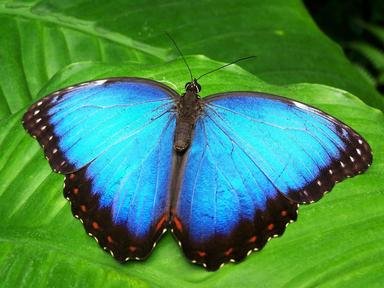Quiz Answer Key and Fun Facts
1. Biologists classify butterflies and moths under the order "Lepidoptera". What does this Greek-derived term mean in English?
2. Though butterflies are usually attracted to flowering plants, they do not get their nutrition from plants as a rule. Rather, they eat the small gnats and other bugs that are also attracted to flowers.
3. One of the more striking characteristics of the butterfly is its development from an egg to a beautiful adult. Adults lay eggs, which hatch wingless larvae (caterpillars) that grow and eat voraciously. They then enter a dormant stage, from which they emerge as adult butterflies. Which of these terms does not refer to this dormant stage?
4. In addition into their culturally-charged "rebirth into beauty", butterflies, like birds and other animal orders, are also renowned for their remarkable diversity. In addition to the marked differences between species of butterflies, differences between males and females of the same species can be so exaggerated that most casual observers would not guess that butterfly "brothers and sisters" were even related.
5. Another example of butterflies' remarkable diversity is the subtle variations between species and subspecies, leading to an amazing multiplicity of appearances. Continuous variation of this sort is known as a "cline", and butterfly clines can be so subtle that there is considerable debate at times about where one species ends and another begins, especially since individuals at one end of a cline are often incapable of breeding with those at the opposite end.
One major factor influencing the development of butterfly clines is geography. Which of these is generally true of how geography influences butterflies' adaptation?
6. Perhaps the most famous of all butterfly species, this North American butterfly is known for its annual migrations ranging between southern Canada and central Mexico. Intriguingly, no one individual usually makes the round trip; rather, migrating populations stop to breed along the way wherever they find milkweeds, and their broods continue the journey. What is the common name of this remarkable creature which carries the scientific name "Danaus plexippus"?
7. The international organization Butterfly Conservation Europe has designated several locations as "Prime Butterfly Areas". One such site is the Kresna Gorge along the Struma River. In addition to the presence of several important butterfly populations in its evergreen juniper forests, it is also the home of several rare species that can only be found a few places in the world. In which country can this unique area of butterfly conservation be found?
8. Butterflies and moths have a number of defenses against predators like birds, lizards, and even other insects. These include camouflage, false eyespots (which make the butterfly look like a much larger opponent) and false heads that misdirect predators that hunt by sight. Perhaps most intriguing is the Lepidopteran defense against bats. Which of these adaptations are moths and butterflies known to use against the flying mammals?
9. Though most cultural uses of the butterfly focus on its beauty, fragility, and seeming rebirth, there are more sinister legends about these fascinating creatures. In the Balkans, for example, vampires were long thought to assume the form of a butterfly or moth!
10. The English word for daylight loving Lepidoptera, "butterfly", comes from an old belief that the winged beauties stole milk. A more prosaic term from another language, "babochka", derives from that tongue's term for "grandmother". What language so lovingly names this cherished insect?
Source: Author
stuthehistoryguy
This quiz was reviewed by FunTrivia editor
crisw before going online.
Any errors found in FunTrivia content are routinely corrected through our feedback system.


